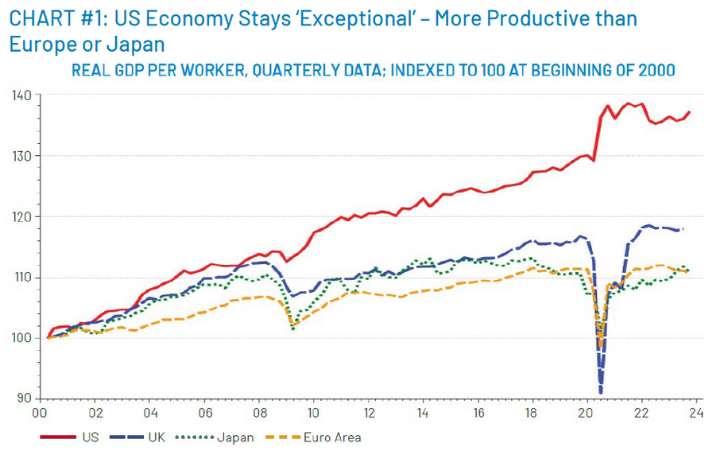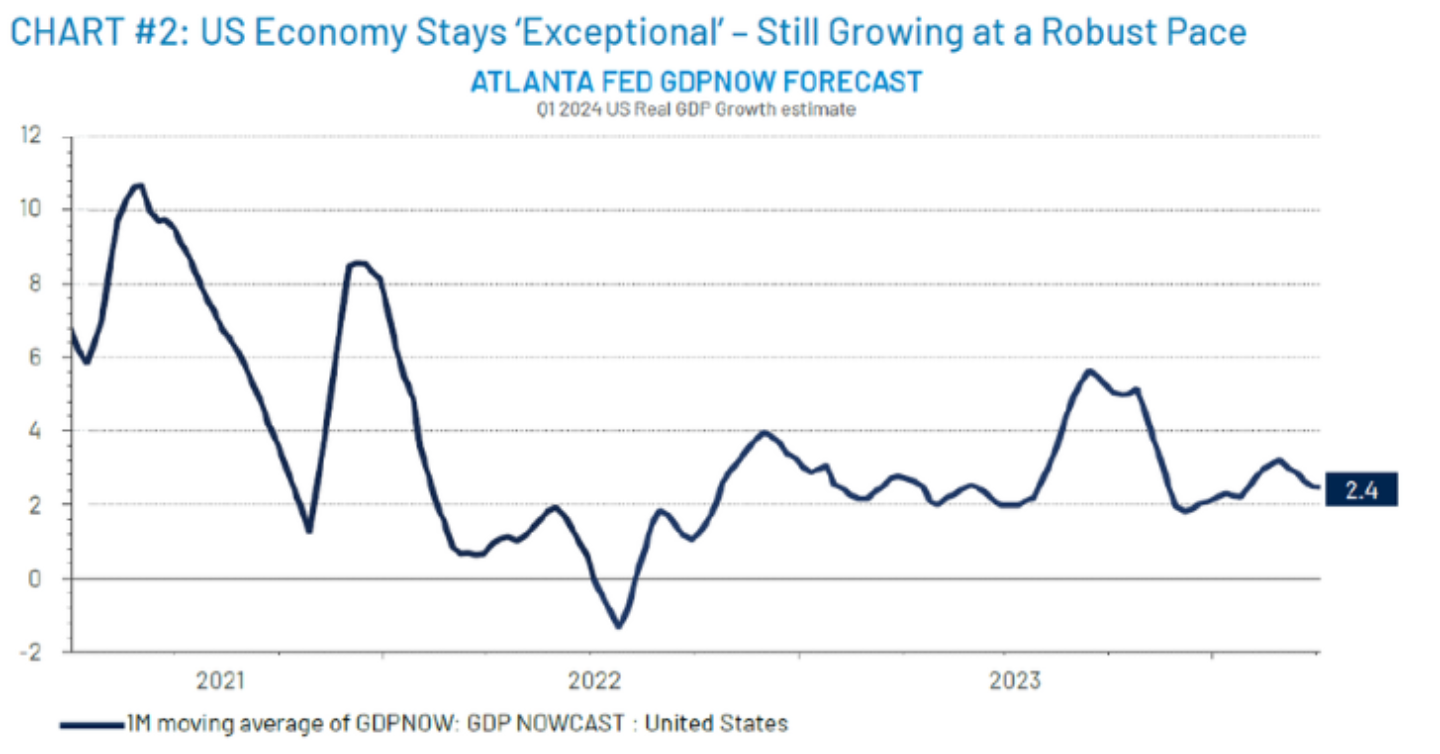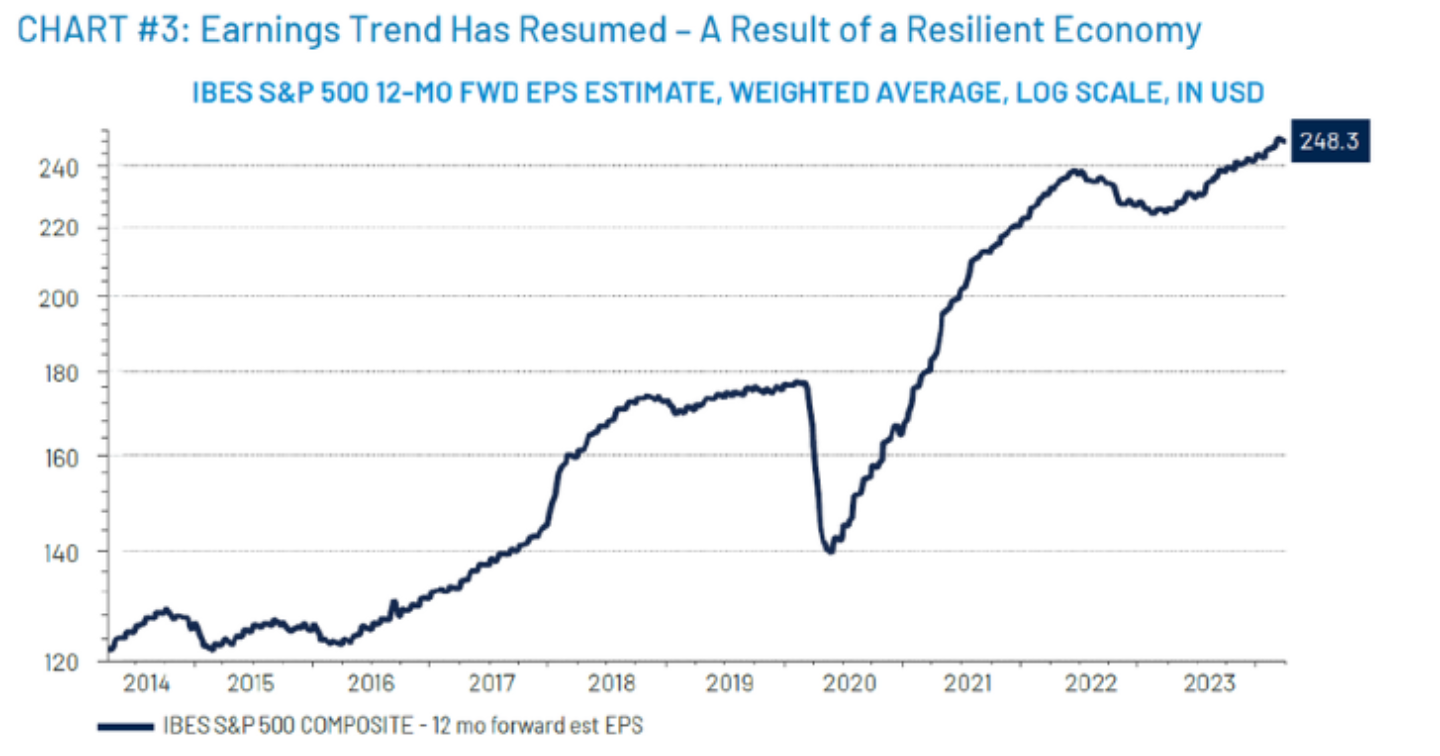By Chris Konstantinos, Managing Partner, Chief Investment Strategist
SUMMARY
- US economy more productive than international peers, according to current real GDP per worker figures.
- US GDP growth remains robust, which we think bodes well for corporate earnings.
- We remain optimistic on US stocks.
In today’s Weekly View, we created a concise synopsis of three selected visuals from our April 2024 Chart Pack. Q1 represented a strong start to 2024 for stocks, reflecting solid corporate earnings trends. Thus far, the start of the year has exceeded our expectations, but there’s still a lot of time left in the year for a few scares. There’s plenty of things for nervous people to worry about in ‘24: Fed policy uncertainty, a contentious Presidential election, a weak Chinese economy, and an equity rally with ‘narrow’ leadership.
We do not lightly dismiss these near-term concerns. On the contrary, if the market follows a typical Presidential election year pattern, the first half of 2024 is likely to be choppy and volatile before eventually resolving to the upside later in the year. However, even incorporating all these risks, we remain optimistic on US stocks. This view is due in large part to the resiliency of the US corporate sector, which we expect to generate positive earnings growth again this year, as well as positive election year historical patterns. Our asset allocation portfolios are overweight stocks, with an emphasis on the US.

We believe there is strong evidence of what we call ‘American economic exceptionalism’. This refers to our view that the US economy is structurally more robust and resilient than its’ developed world peers. Chart 1 (above) measuring real GDP per hour worked, suggests that US productivity has been on the rise for decades, and seems to have accelerated on a relative basis since the pandemic.

The US economy continues to defy the naysayers, with Q1 GDP projected to be above 2%, according to the Atlanta Fed’s ‘GDPNow’ forecasting model. The US economy – the world’s largest – is 11% larger today than it was in 2019. Meanwhile, Germany and Japan’s economies are essentially the same size as pre-pandemic, and France and the UK are only marginally bigger.

For US stocks, being connected to a more productive, growing economy has myriad benefits… not least of which is the strong long-term correlation between US GDP growth and corporate earnings growth. While interest rates are a powerful driver of near-to-intermediate term stock sentiment and valuations, in our view corporate earnings are the more durable longer-term driver of a stock market’s returns (see our 2024 Outlook for more on this topic). Our Outlook calls for corporate earnings to be stronger than consensus believes in 2024.
Risk Discussion: All investments in securities, including the strategies discussed above, include a risk of loss of principal (invested amount) and any profits that have not been realized. Markets fluctuate substantially over time, and have experienced increased volatility in recent years due to global and domestic economic events. Performance of any investment is not guaranteed. In a rising interest rate environment, the value of fixed-income securities generally declines. Diversification does not guarantee a profit or protect against a loss. Investments in international and emerging markets securities include exposure to risks such as currency fluctuations, foreign taxes and regulations, and the potential for illiquid markets and political instability. Please see the end of this publication for more disclosures.
For more news, information, and strategy, visit the ETF Strategist Channel.
Important Disclosure Information:
The comments above refer generally to financial markets and not RiverFront portfolios or any related performance. Opinions expressed are current as of the date shown and are subject to change. Past performance is not indicative of future results and diversification does not ensure a profit or protect against loss. All investments carry some level of risk, including loss of principal. An investment cannot be made directly in an index.
Information or data shown or used in this material was received from sources believed to be reliable, but accuracy is not guaranteed.
This report does not provide recipients with information or advice that is sufficient on which to base an investment decision. This report does not take into account the specific investment objectives, financial situation or need of any particular client and may not be suitable for all types of investors. Recipients should consider the contents of this report as a single factor in making an investment decision. Additional fundamental and other analyses would be required to make an investment decision about any individual security identified in this report.
Chartered Financial Analyst is a professional designation given by the CFA Institute (formerly AIMR) that measures the competence and integrity of financial analysts. Candidates are required to pass three levels of exams covering areas such as accounting, economics, ethics, money management and security analysis. Four years of investment/financial career experience are required before one can become a CFA charterholder. Enrollees in the program must hold a bachelor’s degree.
All charts shown for illustrative purposes only. Technical analysis is based on the study of historical price movements and past trend patterns. There are no assurances that movements or trends can or will be duplicated in the future.
Stocks represent partial ownership of a corporation. If the corporation does well, its value increases, and investors share in the appreciation. However, if it goes bankrupt, or performs poorly, investors can lose their entire initial investment (i.e., the stock price can go to zero). Bonds represent a loan made by an investor to a corporation or government. As such, the investor gets a guaranteed interest rate for a specific period of time and expects to get their original investment back at the end of that time period, along with the interest earned. Investment risk is repayment of the principal (amount invested). In the event of a bankruptcy or other corporate disruption, bonds are senior to stocks. Investors should be aware of these differences prior to investing.
In general, the bond market is volatile, and fixed income securities carry interest rate risk. (As interest rates rise, bond prices usually fall, and vice versa). This effect is usually more pronounced for longer-term securities). Fixed income securities also carry inflation risk, liquidity risk, call risk and credit and default risks for both issuers and counterparties. Lower-quality fixed income securities involve greater risk of default or price changes due to potential changes in the credit quality of the issuer. Foreign investments involve greater risks than U.S. investments, and can decline significantly in response to adverse issuer, political, regulatory, market, and economic risks. Any fixed-income security sold or redeemed prior to maturity may be subject to loss.
Investing in foreign companies poses additional risks since political and economic events unique to a country or region may affect those markets and their issuers. In addition to such general international risks, the portfolio may also be exposed to currency fluctuation risks and emerging markets risks as described further below.
Changes in the value of foreign currencies compared to the U.S. dollar may affect (positively or negatively) the value of the portfolio’s investments. Such currency movements may occur separately from, and/or in response to, events that do not otherwise affect the value of the security in the issuer’s home country. Also, the value of the portfolio may be influenced by currency exchange control regulations. The currencies of emerging market countries may experience significant declines against the U.S. dollar, and devaluation may occur subsequent to investments in these currencies by the portfolio.
Foreign investments, especially investments in emerging markets, can be riskier and more volatile than investments in the U.S. and are considered speculative and subject to heightened risks in addition to the general risks of investing in non-U.S. securities. Also, inflation and rapid fluctuations in inflation rates have had, and may continue to have, negative effects on the economies and securities markets of certain emerging market countries.
Definitions:
Gross domestic product (GDP) is a monetary measure of the market value of all final goods and services produced in a period (quarterly or yearly) of time.
The GDP Now nowcast GDP indicator was created by the Atlanta Federal Reserve and combines higher-frequency (e.g., monthly) economic data released before the GDP data to estimate growth in the current quarter.
The Institutional Brokers’ Estimate System (IBES) is a database used by brokers and active investors to access the estimates made by stock analysts regarding the future earnings of publicly traded American companies. Earnings per share (EPS) is calculated as a company’s profit divided by the outstanding shares of its common stock. The resulting number serves as an indicator of a company’s profitability.
RiverFront Investment Group, LLC (“RiverFront”), is a registered investment adviser with the Securities and Exchange Commission. Registration as an investment adviser does not imply any level of skill or expertise. Any discussion of specific securities is provided for informational purposes only and should not be deemed as investment advice or a recommendation to buy or sell any individual security mentioned. RiverFront is affiliated with Robert W. Baird & Co. Incorporated (“Baird”), member FINRA/SIPC, from its minority ownership interest in RiverFront. RiverFront is owned primarily by its employees through RiverFront Investment Holding Group, LLC, the holding company for RiverFront. Baird Financial Corporation (BFC) is a minority owner of RiverFront Investment Holding Group, LLC and therefore an indirect owner of RiverFront. BFC is the parent company of Robert W. Baird & Co. Incorporated, a registered broker/dealer and investment adviser.
To review other risks and more information about RiverFront, please visit the website at riverfrontig.com and the Form ADV, Part 2A. Copyright ©2024 RiverFront Investment Group. All Rights Reserved. ID 3512273

